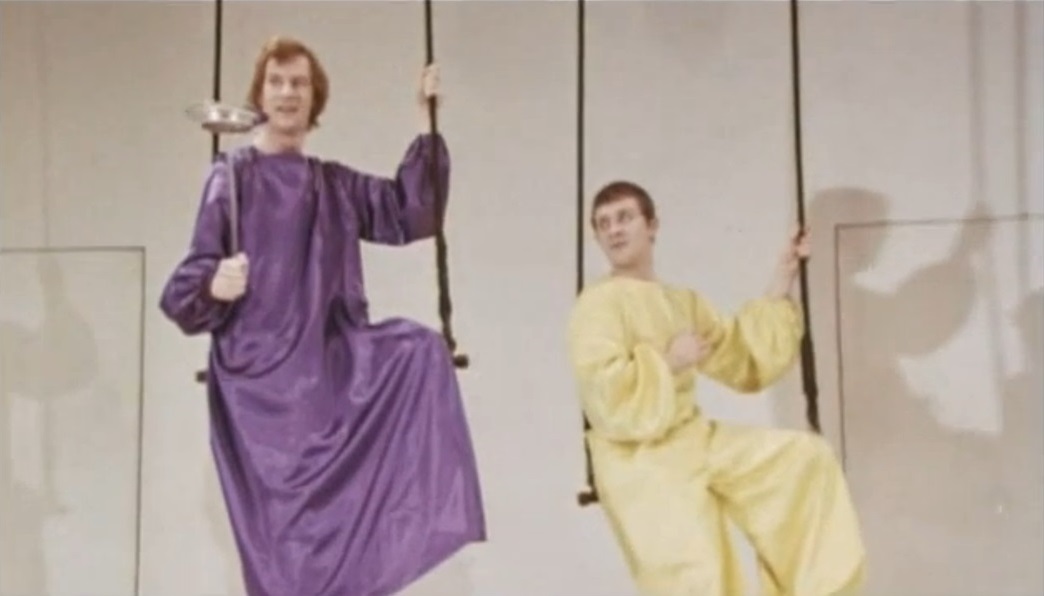Your film critic is a disciple of the arts, he
remembers from school the thing, he’ll tell you it’s been tampered
with, “interfering with a minor,” he’ll practically say.
Let alone the fact that Sir Arthur Bliss and Christopher
Fry and Brook have filmed a musical out of the thing, and that under Herbert
Wilcox’s hand Brook has wrought something Powell & Pressburger would
not have disowned, no no, the satirical intent of the original must be
preserved. And so it has.
Moderato
Cantabile
The material is further reworked and analyzed in
Dassin’s 10:30 P.M. Summer.
“As baffling as a woman’s
intuition,” said Bosley Crowther of the New York Times.
And yet it works both ways, the earlier film sheds
a light on the later.
Lord of the Flies
A deeply analytical view of the war, from the
vantage point of an island full of refugee children.
By an Emersonian proceeding, Golding separates the sheep and the goats, exemplified in
Piggy and Jack. The problem was to find a practical way to render such a
proceeding cinematic. Ralph is the Fritz Lang mediator.
A kinship to the
conclusion of Truffaut’s Fahrenheit
451 is evident, and perhaps to Nemerov’s “Truth”
(“around, above my bed, the pitch-dark fly”). The splendid
preparation of a grand metteur en scène
comes to terms with the acuity of the camera, somewhere between Flaherty and
Murnau.
The negligent
remake was preceded by a highly significant one, Michael Ritchie’s
variant The Island. In any event, every critic seems to have missed the
boat.
The allegory,
which is very fine, is yet surpassed by the telling accuracy of the images in
this “true story of Camberley”.
The Persecution and
Assassination of Jean-Paul Marat as Performed by the Inmates of the Asylum at
Charenton under the Direction of the Marquis de Sade
An absolute,
perfect revolutionary, Marat, beyond all ideals, hopes, wishes or dreams,
bleeding into his bath.
His entertainment
is prepared by De Sade, who has seen it all through from the storming of the
Bastille to the Empire.
Watkin, who is to
color cinematography what Toland is to black-and-white, has the set to
commandeer with its lighting effects (beautifully controlled by a slow pan
left, just before the historical update) and the variegated direction.
Every means is
brought to bear upon the fool, who sits like Satan frozen in ice while the
narcolept makes her way through the crowded asylum like a pilgrim past the
shoals of Duperret the erotomaniac and De Sade the thaumaturge and the nuns in
attendance, another Judith per the script. De Sade laughs at the inmates’
revolution, a madhouse verbatim.
King Lear
Brook has the
scenic plan of Bergman’s Virgin Spring for a springboard, and the
silent film intertitles used sparingly lend the crowning touch (he furthermore
takes from Peckinpah in Ride the High Country his final scene).
It has vividly
portrayed the dilemma of two crowns with the egg eaten up, and it has brought
to the screen precisely the images of flood and ruin and dead rats that it
entails.
This is a
recurrent theme, Macheath’s two hussies, Gurdjieff’s reconciled
opposites (contrariwise Jack and Ralph, Marat and De Sade).
Brook has taken
off from the point achieved by Welles very famously, which is a wise thing to
do and quite in Brook’s vein after his appreciation of The Archers in The
Beggar’s Opera.
A Midsummer Night’s
Dream

A renowned
production doubtless to be explained with reference to Dali’s 50 Secrets of Magic Craftsmanship.
Painting is
indeed the key, a mysterious stillness and equipoise governs the players on
their circus apparatus, quite like the inner workings of a canvas.
Doubling the
leads at last presents, long before Resnais, the Shakespearean mirror
structure.
Meetings With Remarkable Men
The direct
antithesis of King Lear, in the sense of perishing opposites casting out
the rightful lord and then the search for a kingdom based in the event on everlasting
union of opposed forces.
Tacitly the
cross, the Invention of the True Cross under all the snows and sands of Egypt
and Afghanistan and wherenot. The succession of trials is lightly amusing with
the high comedy added of “American canaries” painted to secure a
rare book that is valueless.
The secret
dancing that is an alphabet made vocal comes as recognizable stages, Hawaiian
maidens en masse, an inflexible angle of Nijinska’s Les Noces
with a soloist in one of Merce Cunningham’s freer responses, and the
general geometry of a Balanchine corps dancing along Nijinska’s or
Nijinsky’s (Le Sacre du printemps) lines.